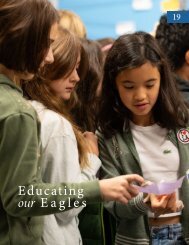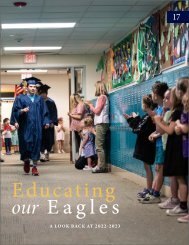Educating Our Eagles - 11/2021
A publication of the Southern Berkshire Regional School District. Once a month we will be highlighting our students and teachers as they work together to grow and learn. The goal of this newsletter is to provide you with a window into our day-to-day experiences and an opportunity to see into our classrooms. Each day we strive to create interactive and highly engaging lessons that support and inspire all learners.
A publication of the Southern Berkshire Regional School District.
Once a month we will be highlighting our students
and teachers as they work together to grow and learn.
The goal of this newsletter is to provide you with a
window into our day-to-day experiences and an
opportunity to see into our classrooms. Each day we
strive to create interactive and highly engaging lessons
that support and inspire all learners.
- TAGS
- instruction
- educating
Create successful ePaper yourself
Turn your PDF publications into a flip-book with our unique Google optimized e-Paper software.
HIGH SCHOOL:
Ninth grade Independent Reading Ads
After selecting and
reading a novel independently,
ninth
grade students wrote a
sixty-second review to
sell the novel on radio.
Anonymous first drafts were shared onscreen
for peer critique and to generate
a list of best practices and corrections.
Second drafts were revised and refined
for impact. Students also created a visual
ad with a selected quote from their independent
reading.
As a result of instruction, students
will be able to:
• Demonstrate knowledge through summary
and review at the end of selfpaced
reading
• Peer critique to establish best practices
and norms
• Generate rules of recorded public
speaking
• Deliver work spanning two forms of
public media.
Observations:
Although many students enjoyed the
opportunity to read for the pleasure of
reading, some students can focus on
developing motivation, time management
and other self-regulating skills.
Particularly useful was for students to
review anonymous peer work on-screen,
identifying successes as well as mistakes
that became an editing checklist for their
own work. Students who are uncomfort-
able with front-of-class public speaking
appreciated the opportunity to record
audio.
Anchor standards:
Reading 2: Determine central ideas or
themes of a text and analyze their development
(47)
Reading 10: Read and comprehend
complex literary texts independently
and proficiently (47)
Writing 2: Write informative/explanatory
texts to examine and convey complex
ideas (53)
Writing 4: Produce clear and coherent
writing in which the development, organization
and
style are appropriate
to task,
purpose and
audience (53)
Writing 6: Use
technology ...
to produce and
publish writing
and to interact
with others (53)
Speaking and
Listening 1:
Prepare for and
participate effectively in a range of conversations
(60)
Speaking and Listening 6: Adapt speech
to a variety of contexts and communicative
tasks (60)
W
e start off with
an activator on
a map of the Korean
peninsula.
Tenth grade students
labeled the
blank map of Korea with the 3 kingdoms
we discussed in the previous class. Next,
I introduced our supporting question for
the lesson: “How has Korea served as both
a cultural bridge and a battleground between
China and Japan?”. Once we have a
discussion about our supporting question
we transitioned into a slide-show on our
new content (Feudalism in Japan). Each
student receives an outlined version of
the notes they fill out on their own as we
go. Once we get to the societal structure
of Japan’s feudal age the students fill out a
pyramid of the social hierarchy (Emperor,
shogun, samurai, etc.). After the pyramid
we watched a Ted Ed of “A Day in the
Life of a Samurai”. We discussed the video
and moved onto our Exit Ticket, a guided
reading about the new content they’ve received
during the lesson.
As a result of instruction,
students will be able to:
• Be able to access prior knowledge on
the geography of the Korean peninsula
• Be able to understand the relationship
Korea & Japan have together.
• Be able to explain Feudalism in Japan,
including details on the social hierarchy
as well as the characteristics of the
samurai
Observations:
Students enjoyed filling out the map and
the pyramid diagram. Students enjoyed
the video on the samurai and enjoyed
when I lectured on the samurai’s characteristics
(weapons, armour, Bushido,
seppuku, etc.). Students were not so enthralled
with lecturing on the semantics
of Japanese society during the Feudal Age.
Frameworks:
HIGH SCHOOL
Transition from Korean Dynasties
to Feudalism in Japan
Physical and political geography of East
Asia [7.T2a]
On a political map of the region, demonstrate
map reading skills to distinguish
countries, capitals, and other cities and
to describe their absolute location and
relative location (relationship to other
countries, cities, or bodies of water); use
knowledge of maps to complement information
gained from text about a city,
country or region
c. Ancient Japan and Korea, c.300 BCE–
1300 CE [7.T2c] Supporting Question:
How has Korea served as both a cultural
bridge and a battleground between China
and Japan?
The Kamakura Shogunate (c. 1185–1333
CE) in Japan, feudal military rule, invasions
of the Mongol Empire, restoration
of temples destroyed in war, Buddhist
sculpture, calligraphy influenced by Zen
Buddhism
EDUCATING OUR EAGLES
10 EDUCATING OUR EAGLES 11


















